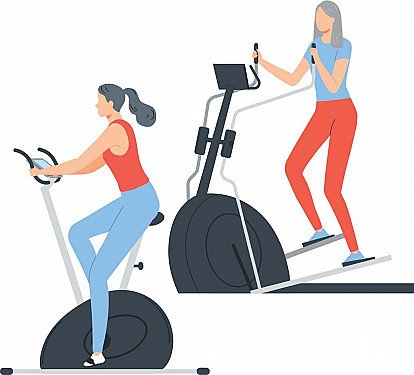4 exercise trends to try
Some trends are high-tech, and some go back to basics.

One of the best ways to sustain an exercise regimen is to find an activity that appeals to you. And four new exercise trends may pique your interest. They're not age-specific and most can be tailored to your needs. But they do have pros and cons.
1. Circuit training
When people talk about circuit training in 2020, they're probably not referring to working out on a series of weight machines. Today's circuit consists of a series of exercises, set up at separate "stations" in various parts of a large exercise room. "The exercises focus on agility, balance, or strength, and they alternate between upper- and lower-body movements to avoid excessive fatigue in any one muscle group," says Michael Bento, a personal trainer at Harvard-affiliated Massachusetts General Hospital.
For example, you might be directed to do 10 squats, run through a pattern of cones, do 10 push-ups, jump rope for 30 seconds, and lift small weights; it depends what the instructor sets up for you. A workout consists of doing the circuit several times in a row, to keep you moving and elevate your heart rate.
Pros: This workout is varied and can be different each time, which makes it interesting. Plus, you get an aerobic workout — the kind that gets your heart and lungs pumping.
Cons: Not knowing what to expect may catch you off guard if there's an exercise that's too challenging. Talk to your instructor in advance to learn how to modify the routine if needed.
2. Cognitive workouts
These workouts combine aerobic exercise with basic brain challenges — two great ways to keep your mind sharp. In addition to guiding you through a fitness class, your instructor also leads you through verbal brain games that you answer while exercising. For example, you might be asked to count backward by twos, call out the name of the president in a certain year, or remember three numbers that you'll have to recite later.
Pros: "Cognitive workouts pose 'dual task' challenges for the brain — your brain has to allocate resources to the physical activity and the cognitive task. That engages the frontal lobes, an important part of the brain for decision making, controlling impulses, planning, and other executive functions," says Dr. Alvaro Pascual-Leone, a senior scientist at the Arthur and Hinda Marcus Institute at Harvard-affiliated Hebrew SeniorLife.
Cons: These classes are so new that they're hard to find, but they're popping up in health clubs across the country. Ask your gym if it offers any fitness classes that incorporate cognitive challenges or brain games.
3. Battle ropes
Shaking and whipping large, heavy ropes that are anchored to a wall is popular with younger adults and can be beneficial and fun for older adults, too. The ropes come in different weights, and you typically take a squatting stance as you shake them in order to stabilize your body. An instructor guides you through the movements necessary to complete a workout. "If you make little waves with the ropes for a period of time, you get an aerobic workout. If you slam the ropes down or make bigger waves, that builds strength and power," Bento explains.
Pros: This is a fun way to improve muscle strength and endurance, and it's easily modified to your ability.
Cons: Raising and lowering the ropes with force may cause injury if you have shoulder or back problems.
4. Streaming workouts
You're at home, but your health club or personal trainer is across town or across the country. Thanks to technology, it doesn't matter. No matter where you are, you can take part in an exercise class as it's happening or get individual personal training by "live streaming" a workout — that is, watching it live via computer or smartphone.
Many companies offer streaming workout subscriptions. You sign up online, then pay a flat monthly fee — anywhere from $15 to $100 per month.
Pros: Unlike using a recorded workout video, streaming a workout provides all the excitement of taking part in a live exercise class without having to go to a gym, and in some cases it's cheaper than paying for a health club membership. Plus, you can find a wide variety of exercise styles and intensities to match your needs — everything from cardio, strength, flexibility, or high-intensity interval training to yoga, Pilates, or tai chi. If you're working with a personal trainer for individual training, you can talk back and forth with your instructor via video chat.
Cons: "The instructor may not be aware of your limits and needs, and may not be able to see if you're using the proper form. And if you're unfamiliar with the program, you may be risking injury," Bento says.
For this or any new type of workout you're interested in, Bento advises checking with your doctor first to see if it will be both safe and beneficial.
Image: © DisobeyArt/Getty Images
Disclaimer:
As a service to our readers, Harvard Health Publishing provides access to our library of archived content. Please note the date of last review or update on all articles.
No content on this site, regardless of date, should ever be used as a substitute for direct medical advice from your doctor or other qualified clinician.















